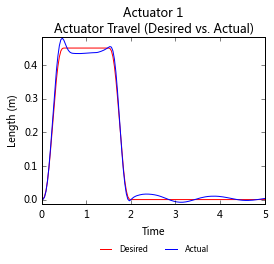Controller
A controller is provided as a way to try and reach a desired (target) value by means of a feedback control loop.
 that
allows you to disable the controller.
that
allows you to disable the controller.
Figure 1. Controller Option for Motors

Figure 2. Controller Option for Actuators
Types of Controllers
- PID
- Soft Constraint (available for angle motors and displacement actuators only)
PID Controller
- Proportional Gain
- Integral Gain
- Derivative Gain
Soft Constraint Controller
A soft constraint is not a conventional controller, but more like a mathematical constraint with some violation allowed. (That is why it is a soft constraint, as opposed to a hard constraint which allows no violation.)
- Proportional Factor
- Derivative Factor
Example
This plot shows a case of a soft constraint controller overshooting the desired step-dwell-step profile function.
